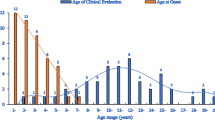Abstract
We applied multiple ligation-dependent probe amplification (MLPA) to patients from three families with characteristic dopa-responsive dystonia (DRD) but no base change in the gene GCH1. We found a complete deletion of GCH1 in affected members of family 1, and partial deletions in affected individuals of family 2 (exons 4–6) and of family 3 (exons 2–6). The findings were confirmed by quantitative real-time PCR. Our investigations demonstrate the utility of MLPA for routine deletion analysis of GCH1 in DRD patients with no sequence changes in this gene.



Similar content being viewed by others
References
Nygaard TG, Trugman JM, de Yebenes JG, Fahn S (1990) Dopa-responsive dystonia: the spectrum of clinical manifestations in a large North American family. Neurology 40:66–69
Müller U, Steinberger D, Topka H (2002) Mutations of GCH1 in dopa-responsive dystonia. J Neural Transm 109:321–328
van Hove JL, Steyaert J, Matthijs G, Legius E, Theys P, Wevers R, Romstad A, Moller LB, Hedrich K, Goriounov D, Blau N, Klein C, Casaer P (2006) Expanded motor and psychiatric phenotype in autosomal dominant Segawa syndrome due to GTP cyclohydrolase deficiency. J Neurol Neurosurg Psychiatry 77:18–23
Nygaard TG, Marsden CD, Duvoisin RC (1988) Dopa-responsive dystonia. Adv Neurol 50:377–384
Steinberger D, Weber Y, Korinthenberg R, Deuschl G, Benecke R, Martinius J, Müller U (1998) High penetrance and pronounced variation in expressivity of GCH1 mutations in five families with dopa-responsive dystonia. Ann Neurol 43:634–639
Ichinose H, Ohye T, Takahashi E, Seki N, Hori T, Segawa M, Nomura Y, Endo K, Tanaka H, Tsuji S, Fujita K, Nagatsu T (1994) Hereditary progressive dystonia with marked diurnal fluctuation caused by mutations in the GTP cyclohydrolase I gene. Nat Genet 8:236–242
Thöny B, Blau N (2006) Mutations in the BH4-metabolizing genes GTP cyclohydrolase I, 6-pyruvoyl-tetrahydropterin synthase, sepiapterin reductase, cabinolamine-4a-dehydratase, and dihydropteridine reductase. Hum Mutat 27:870–878
Steinberger D, Korinthenberg R, Topka H, Berghäuser M, Wedde R, Müller U (2000) Dopa-responsive dystonia: mutation analysis of GCH1 and analysis of therapeutic doses of L-dopa. Neurology 55:1735–1737
Livak KJ (1997) Comparative Ct method. ABI Prism 7700 Sequence Detection System. User Bulletin no. 2. PE Applied Biosystems, CA, USA
Furukawa Y, Guttman M, Sparagana SP, Trugman JM, Hyland K, Wyatt P Lang AE, Rouleau GA, Shimadzu M, Kish SJ (2000) Dopa-responsive dystonia due to a large deletion in the GTP cyclohydrolase I gene. Ann Neurol 47:517–520
Klein C, Hedrich K, Kabakci K, Mohrmann K, Wiegers K, Landt O, Hagenah J, Schwinger E, Pramstaller PP, Ozelius LJ, Gucuyener K, Aysun S, Demir E (2002) Exon deletions in the GCH1 gene in two of four Turkish families with dopa-responsive dystonia. Neurology 59:1783–1786
Hagenah J, Saunders-Pullman R, Hedrich K, Kabakci K, Habermann K, Wiegers K, Mohrmann K, Lohnau T, Raymond D, Vieregge P, Nygaard T, Ozelius LJ, Bressman SB, Klein C (2005) High mutation rate in dopa-responsive dystonia: detection with comprehensive GCHI screening. Neurology 64:908–911
Hirano M, Ueno S (1999) Mutant GTP cyclohydrolase I in autosomal dominant dystonia and recessive hyperphenylalaninemia. Neurology 52:182–184
Suzuki T, Ohye T, Inagaki H, Nagatsu T, Ichinose H (1999) Characterization of wild-type and mutants of recombinant human GTP cyclohydrolase I: relationship to etiology of dopa-responsive dystonia. J Neurochem 73:2510–2516
Acknowledgements
Investigation of probands was performed according to the principles of the World Medical Association Declaration of Helsinki (WMA General Assembly, 2004). Jutta Trübenbach and Birgit Zirn contributed equally to this work.
Author information
Authors and Affiliations
Corresponding authors
Additional information
An erratum to this article can be found at http://dx.doi.org/10.1007/s10048-006-0073-x
Rights and permissions
About this article
Cite this article
Steinberger, D., Trübenbach, J., Zirn, B. et al. Utility of MLPA in deletion analysis of GCH1 in dopa-responsive dystonia. Neurogenetics 8, 51–55 (2007). https://doi.org/10.1007/s10048-006-0069-6
Received:
Accepted:
Published:
Issue Date:
DOI: https://doi.org/10.1007/s10048-006-0069-6




